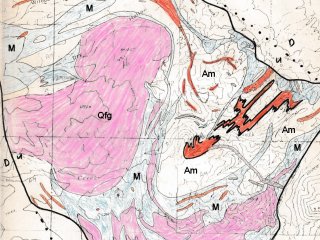 Master's thesis: PDF format
Master's thesis: PDF format

The marble, quartzitic gneiss and iron-formation in the area clearly originated as sedimentary units. The hornblende gneiss assemblage was also found to be dominantly sedimentary in origin. Evidence for this includes its association with marble and quartzitic gneiss, the latter intimately mixed within it, the presence of meta-conglomerates, and the abundance of quartz making the composition distinctly different from normal igneous rocks. A petrographic estimate of composition for one amphibolite showed it to most resemble a dolomitic shale. It is possible that some amphibolites in the area are metamorphosed dikes and sills. The uniform granitic composition and lack of structures in the quartz-feldspar gneiss suggest an igneous origin for this unit.
Metamorphism in the area exceeded the sillimanite-orthoclase zone of the amphibolite facies as indicated by the presence of sillimanite, perthite, and calcic plagioclase An42. The presence of the assemblage quartz-hypersthene-garnet, and textures indicating the reaction anthophyllite ? enstatite + quartz show that conditions ran locally into the orthopyroxene zone of the granulite facies. These probably represent areas locally undersaturated in water.
The area went through two phases of regional deformation. The first event, roughly contemporaneous with the highest metamorphic grades, produced similar-style, tight isoclinal folds and the regional foliation. Subsequent to that, the area was folded into a large, concentric, open antiform-synform pair trending northeasterly and plunging at moderate to steep angles. Small super-imposed folds of undetermined age relationship to the second event also exist.
 Master's thesis: Book format [Not yet available]
Master's thesis: Book format [Not yet available]
Basement Geoloical Map.
Structural Cross-section with interpreted pre-metamorphic sedimentary facies.
Sample Location Map.
Station location Map.